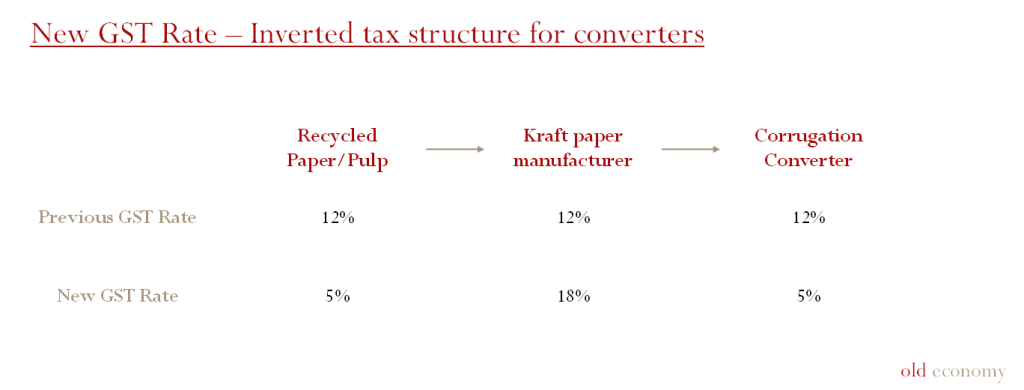>> Special Insight : India GST changes – impact on paper sector
The GST effect – Kraft and corrugation businesses need more working capital, but ability to pass through costs limited
23 September 2025
In new rates that became effective on 22nd September 2025, the GST Council of India increased the tax rate on paper and paperboard from 12% to 18%, while pulling the tax on corrugated boxes down to 5%, from 12% earlier. The GST hike on upstream while reduction on downstream creates an inverted GST structure that has put converters under pressure due to higher working capital requirements. Paper manufacturers selling on credit will also need to bear higher working capital costs.

“As a manufacturer, my working capital will rise. Converters will now require more time to clear the credit amount as they are unable to pass on the hike in production costs to customers” a top kraft paper manufacturer in northern India told Old Economy.
“Pressure on converters is going to put some stress on paper sales as well. When there is such stress, micro and small units are going to face a tough time as meeting capital requirements can be difficult. Capital has one of the highest shares in our costs”, he added.
Though converters will get a refund on the tax differential, the process involves a few weeks. An official at India’s Paper Manufacturers Association said, “The government should bring kraft paper in line with boxes as the differential of 13% will not benefit a B2B segment. Converters will have to bear with the refund process which is long and leads to a block on working capital.”
Any GST rate change unlikely until the Council reconvenes
The industry body has submitted a proposal to the government to change tax on kraft paper to 5% instead of 18%, to put it at par with the value chain. However, this may not be reviewed until the next meeting of the GST Council, as yet unscheduled.
A corrugator said, “Ultimately, if there is no revision in GST by year end, then converters will start looking at passing on their costs to consumers. Most of the clients are multinational corporations (MNCs) and a rise in working capital due to GST amendments doesn’t allow the contract price with the buyer to change. Only a high variation in paper prices allows for a change.”
GST impact on other paper categories
GST on uncoated printing and writing paper has risen from 12% to 18%. Manufacturers said enquiries were low, and order volumes had reduced as printers are facing a rise in costs and finding it difficult to pass on their costs to buyers.
GST on pulp and waste paper has been lowered from 12% to 5%.
Newsprint saw no change in GST rate, which remains at 5%. GST on tissue stock also remained unchanged at 18%.
